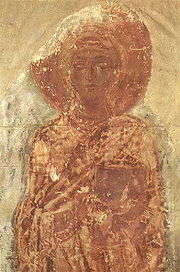Saint Thecla
| Saint Thecla | |
|---|---|

Fresco in Saviour Cathedral of Chernihiv, 11th century
|
|
| Virgin and Martyr | |
| Born |
30 AD Konya, Turkey (Lycaonia) |
| Died | 1st century AD |
| Venerated in |
Oriental Orthodoxy Roman Catholic Church Eastern Orthodox Churches The Episcopal Church |
| Feast | September 23rd (Roman Catholic Church, The Episcopal Church) September 24th (Eastern Orthodox Churches) October 3rd (Coptic Orthodox Church) |
30 AD
Thecla or Tecla (Ancient Greek: Θέκλα, Thékla) was a saint of the early Christian Church, and a reported follower of Paul the Apostle. The earliest record of her life comes from the ancient apocryphal Acts of Paul and Thecla. Although Church Fathers Tertullian and Jerome rejected her story, she enjoyed great popularity in the Byzantine period.
The Acts of Paul and Thecla is a 1st or 2nd century text, which forms part of the Acts of Paul but also circulated separately. According to the text, St. Thecla was a young noble virgin from Iconium who listened to St. Paul's "discourse on virginity", espoused the teachings and became estranged to both her fiancé, Thamyris, and her mother. She sat by her window for three days, listening to St. Paul and his teachings. When they witnessed this, they became concerned that St. Thecla would follow St. Paul's demand "one must fear only one God and live in chastity" and turned to the authorities to punish both St. Paul and St. Thecla.
St. Thecla was miraculously saved from burning at the stake by the onset of a storm and travelled with St. Paul to Antioch of Pisidia. There, a nobleman named Alexander desired St. Thecla and attempted to rape her. St. Thecla fought him off, assaulting him in the process, and was put on trial for assaulting a nobleman. She was sentenced to be eaten by wild beasts but was again saved by a series of miracles, when the female beasts protected her against her male aggressors. While in the arena, she baptised herself.
She rejoined the Holy Apostle Paul in Myra, travelled to preach the word of God and became an icon encouraging women to imitate her by living a life of chastity and following the word of the Lord. She went to live in Seleucia Cilicia. According to some versions of the Acts, she lived in a cave there for 72 years. As she became a healer, the Hellenistic physicians in the city lost their livelihood and solicited young men to attempt to spoil her virginity at the age of 90. As they were about to take her, she called out to God and a new passage was opened in the cave, and the stones closed behind her. She was able to go to Rome and lie down beside St. Paul's tomb.
...
Wikipedia
